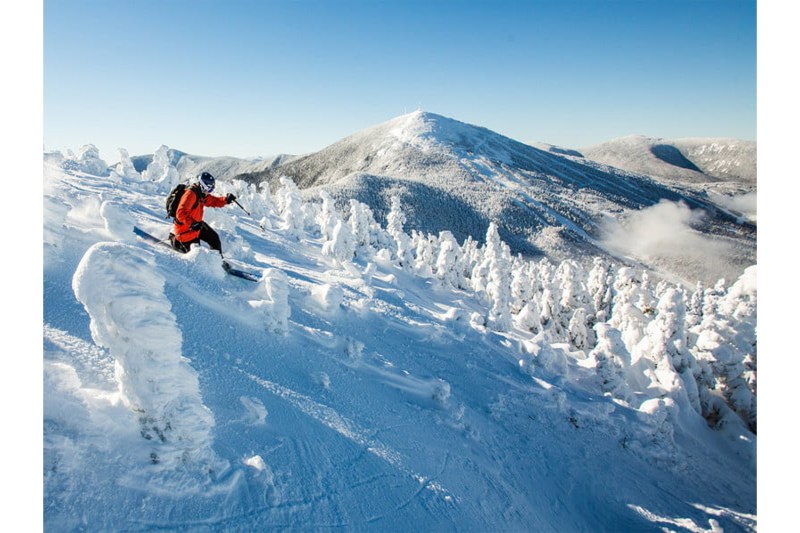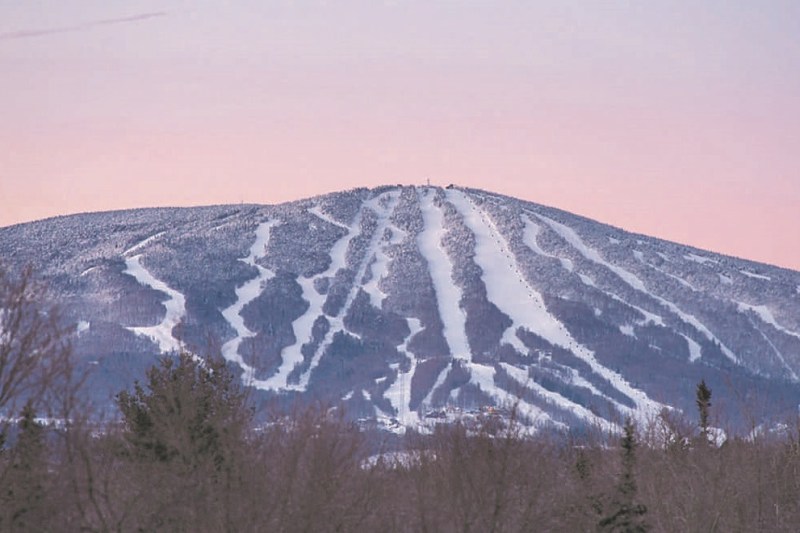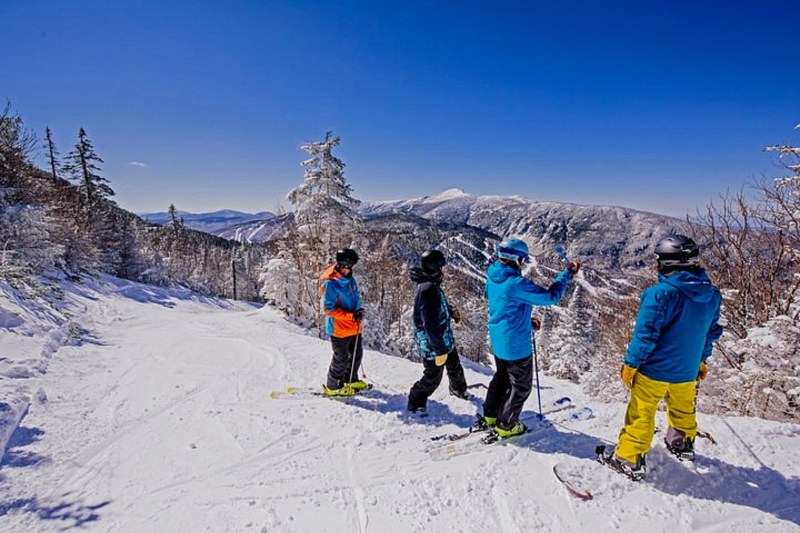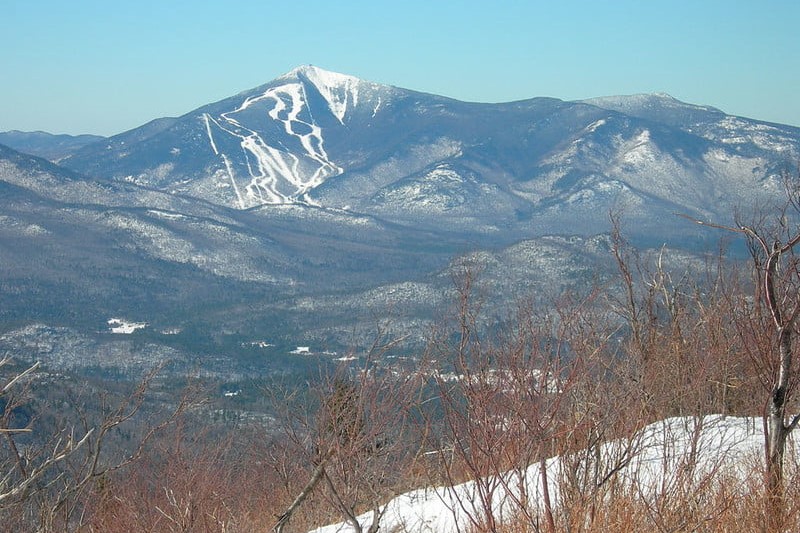
There are two things the East Coast doesn’t lack, mountain ranges and formidable winters. East of the Mississippi River, incredible ski resorts let you challenge some of the East’s best mountains — like those in northern New York’s Adirondacks, Vermont’s Green Mountains, New Hampshire’s White Mountains, and the Alleghenies in Pennsylvania and West Virginia — have been drawing skiers for nearly a century, since the days when slopes were serviced only with rope tows and solely reliant on the natural powder provided by Mother Nature.
While the East Coast may not have the acreage or the altitude of the West’s most iconic ski resorts, the region’s resorts still have plenty to offer, from vertiginous steeps and spellbinding glades to meticulously groomed cruisers perfect for novices. As this season ramps up and the snow starts to settle on the mountaintops, we’re getting to that time of year when you should really have something booked for skiing. But isn’t it time you tried somewhere new, or perhaps a little closer to home by hitting the slopes at some of the best East Coast ski resorts?

Sugarloaf, Maine
In western Maine’s river-sculpted Carrabassett Valley, Sugarloaf thrills with some of the most spectacular alpine terrain east of the Rocky Mountains. Revolving around the hulking figure of 4,237-foot Sugarloaf Mountain — the second-highest peak in Maine — the resort treats skiers to the only lift-serviced terrain situated above the treeline in the East. But, there’s plenty of mountain for all levels of skiers, with more than 1,240 skiable acres, more than 160 trails and glades, and 2,820 feet of vertical. Less experienced skiers can cruise the entire mountain and practice their turns on intermediate-graded Tote Run Road, a 3.5-mile run that is the resort’s longest trail.

Gore Mountain, New York
In northern New York, Gore Mountain spoils skiers with a smorgasbord of terrain and expansive views of the Adirondacks. The historic resort offers seven distinctive mountain areas catering to visitors of all experience levels, with 448 acres of skiable terrain, 120 trails, and eight terrain parks. For seasoned skiers craving steeps, the resort tops out at 3,560 feet on the summit of Gore Mountain and dishes up 2,537 feet of vertical drop, along with 28 glades. Experts can also make tracks at the Burnt Ridge area, home to ‘The Cirque,” which is one of the most extensive glades in the East.

Sunday River, Maine
A perennial East Coast favorite, Maine’s Sunday River Resort spreads over a conglomeration of eight different peaks in the Sunday River chain. Topping out on the crest of the 2,340-foot White Cap, the ski area offers more than 870 skiable acres, including nearly 300 acres of glades, draped with 135 trails, totaling more than 53 miles. For experts, Aurora Peak provides a taste of the resort’s steeps and glades with 13 runs, including the Black Hole, a double black diamond, and the steepest option in the area. In addition to downhill skiing, the Bethel area is also a hub for Nordic skiing. Cross-country skiers can explore the extensive trail network in Bethel at Carter’s XC Ski or at the Bethel Inn Resort, the gateway to the Bethel Village Trails.

Stratton, Vermont
Anchored by the loftiest peak in southern Vermont, within easy reach of New York City, the slopes at Stratton Mountain Resort have been luring skiers since the winter of 1961 and the mountain is renowned for hosting the first World Cup races in the state, in 1978. Today, the ski area has bulged to more than 670 acres, with 99 trails totaling more than 38 miles. With an elevation topping out at 3,875 feet, along with 2,003 feet of vertical, and more than 160 acres of glades, the historic ski area is sure to keep pros entertained. But, Stratton is also an ideal getaway for novices, with about three-quarters of the resort’s slopes graded for beginner and intermediate skiers. And, for a calorie-incinerating break from the downhill, the resort’s Nordic Center features tracks for cross-country skiing, snowshoeing, and fat-tire biking.

Killington, Vermont
Killington is the East Coast’s behemoth. Appropriately nicknamed the “Beast of the East,” the ski area offers the most acreage east of the Mississippi River, combining the slopes at Killington Resort and nearby Pico Mountain. Pico Mountain is one of the most historic ski spots in Vermont, dating back to 1937 when skiers were transported with a single rope tow powered by a car engine. Topping out with 4,241-foot Killington Mountain, Vermont’s second-highest peak, the alpine playground extends over a hodgepodge of seven summits, providing 1,977 skiable acres and 213 trails. Almost half of the area’s total acreage is exclusively for experts, but there’s plenty to enthrall novices too, including the Great Eastern, a 3.5-mile cruiser with the distinction of being Killington’s longest run.

Smuggler’s Notch, Vermont
Fondly referred to as “Smuggs,” northern Vermont’s Smuggler’s Notch Resort is an East Coast behemoth nestled into the Green Mountains just outside the village of Stowe. Featuring more than 1,000 acres of terrain to ski, it is spread over three conjoined mountains with 78 different trails, making a total of 45 acres of gladed area and six terrain parks. Nearly a third of the acreage at Smuggler’s Notch caters to seasoned pros and the resort is home to the only triple black diamond in the East, the aptly named Black Hole. Beyond the array of downhill terrain, the resort also features more than 18 miles of designed cross-country ski trails.

Whiteface Mountain, New York
Situated just outside Lake Placid, New York’s Whiteface Mountain famously featured in the 1980 Winter Olympics as the home of the alpine skiing events. Building on the region’s Olympic legacy, the resort today offers some of the most exhilarating downhill terrain in the east. Covering a trio of summits on eponymous Whiteface Mountain, one of the 46 high peaks in the Adirondacks, the ski area provides 288 acres of skiable terrain with 90 different trails, including 53 acres of glades and a vertical drop of 3,430 feet, the biggest east of the Rocky Mountains. While a little more than half of the resort’s territory caters to beginner and intermediate skiers, there are plenty of pockets just for experts, like the Slides, a 35-acre swath of gladed, double diamond graded wilderness, topping out an elevation of 4,650 feet.

Snowshoe, West Virginia
Boasting some of the most reliable snowfall in the Mid-Atlantic thanks to the blend of altitude and intense lake-effect storms, West Virginia’s Snowshoe Mountain Resort is an East Coast standout. Divided into three distinctive zones — the Snowshoe Basin Area, the Silver Creek Area, and the rugged Western Territory — the resort spreads over the flanks of Cheat Mountain, topping out at 4,848 feet, and it offers 257 skiable acres with 60 trails and 1,500 feet of vertical. For thrill-seekers, the resort’s Western Territory is home to Cupp Run. Designed by legendary French Olympic alpine champion Jean Claude Killy in the 1970s, the run plummets about 1,500 feet over in just 1.5 miles.

Stowe, Vermont
Stowe, Vermont offers 2,630 feet of vertical ski terrain and 116 trails and receives an average of 314 inches of snow a year. If you want to experience something other than just regular skiing, Stowe also features two freestyle terrain parks with obstacles like jumps, ramps, quarter pipe, and other terrain features for you to get that adrenaline rush. The Standard Park is aimed at beginners and intermediate terrain skiers and the Gulch is aimed at entry-level terrain skiers. The resort is nestled into a cute mountain town, Spruce Peak Village, you’ll find delicious food and drink, plenty of shops, and activities to enjoy off the slopes.

Jay Peak, Vermont
Located in Vermont’s Northeast Kingdom right near the Canadian border, Jay Peak is never short of snow during ski season. Because it’s so far north, and not close to major cities, Jay Peak tends to be less crowded than some of the other big East Coast ski resorts. With 81 trails, alongside glades and terrain parks, Jay Peak has something for every level of skier. At its summit, it’s 3,968 feet and it has a vertical drop of 2,153 feet, which is the eighth largest in New England and the fifth largest in Vermont. One thing that Jay Peak has that most of the other resorts on the East Coast don’t is the Pump House, Vermont’s only indoor waterpark. Besides waterslides, hot tubs, and a lazy river, the Pump House also features the Double Barrel Flowrider, an experience that combines skateboarding, surfing, and snowboarding.



